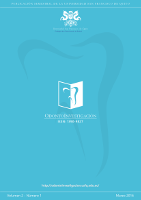Tratamiento Odontológico en Paciente con Trastorno de Déficit de Atención e Hiperactividad
Contenido principal del artículo
Resumen
El Trastorno de Déficit de Atención e Hiperactividad (TDAH) es una de las alteraciones del neurodesarrollo más frecuentes en la infancia, presentándose hasta en un 12% de la población a nivel mundial. El TDAH se caracteriza por manifestaciones de hiperactividad, inatención e impulsividad, así como alteraciones en el sueño y daño en las funciones de ejecución.
Presentación del Caso: Paciente femenino de 10 años de edad con diagnóstico de TDAH actualmente en tratamiento, y que padece fobia hacia los médicos, acude a consulta para valoración y atención odontológica, presentando lesiones cariosas en diversas piezas dentales y una pieza dental retenida (21).
El tratamiento fue llevado a cabo utilizando técnicas mínimamente invasivas, con técnicas de manejo de conducta como Tell-Show-Do y reforzamiento positivo.
Conclusión: El resultado fue altamente satisfactorio, ya que se logró elevar la calidad de vida de la paciente, disminuyendo sus niveles de ansiedad, logrando restaurar su cavidad bucal y mejorando el perímetro de arco, para así poder ser referida a tratamiento de ortodoncia, otorgándole un estado de salud bucal óptimo.
Detalles del artículo
Citas
Hervás A, de Santos T, Quintero J, Ruíz-Lázaro PM, Alda JA, Fernández-Jaén A,Ramos-Quiroga JA. Delphi Consensus onAttention Deficit Hyperactivity Disorder(ADHD): evaluation by a panel of experts.Actas Esp Psiquiatr. 2016;44 (6): 231-43.
Polanczyk, G.; de Lima, M.S.; Horta, B.L.;Biederman, J.; Rohde, L.A. The worldwideprevalence of ADHD: A systematic reviewand metaregression analysis. Am. J.Psychiatry. 2007;164:942-948.
Scahill, L.; Schwab-Stone, M. Epidemiologyof ADHD in school-age children. Child.Adolesc. Psychiatr. Clin. N. Am. 2000;9:541-555.
Willcutt, E.G. The prevalence of DSM-IVattention-deficit/hyperactivity disorder: Ameta-analytic review. Neurotherapeutics.2012;9:490-499.
Huang, C.L.C.; Chu, C.C.; Cheng, T.J.; Weng,S.F. Epidemiology of treated attention-deficit/hyperactivity disorder (ADHD)across the lifespan in Taiwan: A nationwidepopulation-based longitudinal study. PLoSONE. 2014;9:e95014.
Wu X, Ohinmaa A, Veugelers PJ. TheInfluence of Health Behaviours inChildhood on Attention Deficit andHyperactivity Disorder in Adolescence.Nutrients. 2016;2 (8):12.
Spencer, T.J.; Biederman, J.; Mick, E.Attention-deficit/hyperactivity disorder:Diagnosis, lifespan, comorbidities, andneurobiology. J. Pediatr. Psychol.2007;32:631-642.
Vaidyanathan S, Shah H, Gayal T. SleepDisturbances in Children with Attention -Deficit/HyperactivityDisorder (ADHD):Comparative Study with Healthy Siblings. JCan Acad Child Adolesc Psychiatry.2016;25 (3): 145-151.
Passarotti AM, Trivedi N, Dominguez-Colman L, Patel M, Langenecker SA.Differences in Real World ExecutiveFunction between Children with PediatricBipolar Disorder and Children with ADHD.J Can Acad Child Adolesc Psychiatry.2016;25 (3): 185-195.
Rogers DC, Dittner AJ, Rimes KA, ChalderT. Fatigue in an adult attention deficithyperactivity disorder population: A trans-diagnostic approach. Br J Clin Psychol.2016.
Cortese, S.; Angriman, M.; Maffeis, C.;Isnard, P.; Konofal, E.; Lecendreux, M.;Purper-Ouakil, D.; Vincenzi, B.; Bernardina,B.D.; Mouren, M.C. Attention-deficit/hyperactivity disorder (ADHD) andobesity: A systematic review of theliterature. Crit. Rev. Food Sci. Nutr.2008;48:524-537.
Escobar R, Hervás A, Soutullo C,Mardomingo MJ, Uruñuela A, Gilaberte I.Attention deficit/hyperactivity disorder:burden of the disease according tosubtypes in recently diagnosed children.Actas Esp Psiquiatr. 2008;36 (5): 285-94.
Chou, W.J.; Liu, T.L.; Hu, H.F.; Yen, C.F.Suicidality and its relationships withindividual, family, peer, andpsychopathologyfactors amongadolescentswithattention-deficit/hyperactivity disorder. Res. Dev.Disabil. 2016, 53-54, 86-94.
Peasgood, T.; Bhardwaj, A.; Biggs, K.;Brazier, J.E.; Coghill, D.; Cooper, C.L.; Daley,D.; de Silva, C.; Harpin, V.; Hodgkins, P.; etal. The impact of ADHD on the health andwell-being of ADHD children and theirsiblings. Eur. Child Adolesc. Psychiatry.2016;25:1217-1231.
Jensen, C.M.; Steinhausen, H.C. Comorbidmental disorders in children andadolescentswithattention-deficit/hyperactivity disorder in a largenationwide study. Atten. Defic. Hyperact.Disord. 2015;7:27-38.
Pingault, J.B.; Viding, E.; Galéra, C.; Greven,C.U.; Zheng, Y.; Plomin, R.; Rijsdijk, F.Genetic and environmental influences onthe developmental course of attention-deficit/hyperactivity disorder symptomsfrom childhood to adolescence. JAMAPsychiatry. 2015;72:651-658.
Lingineni, R.K.; Biswas, S.; Ahmad, N.;Jackson, B.E.; Bae, S.; Singh, K.P. Factorsassociatedwithattentiondeficit/hyperactivity disorder among USchildren: Results from a national survey.BMC Pediatr.2012;12:50.
Yang R, Li R, Gao W, Zhao Z. Tic SymptomsInduced by Atomoxetine in Treatment ofADHD: A Case Report and LiteratureReview. J Dev Behav Pediatr. 2017;38 (2):151-154.
Leisman G., Melillo R. The basal ganglia:motor and cognitive relationships in aclinical neurobehavioral context. Rev.Neurosci.2013;24 (1): 9-25.
Mink J.W. Advances in Neurology.Lippincott Williams & Wilkins; 2006.Neurobiology of basal ganglia andTourette syndrome: basal ganglia circuitsand thalamocortical outputs; pp. 89-98.
Frodl T., Skokauskas N. Meta-analysis ofstructural MRI studies in children andadults with attention deficit hyperactivitydisorder indicates treatment effects. ActaPsychiatr. Scand.2012;125 (2): 114-126.
Nakao T., Radua J., Rubia K., Mataix-Cols D.Gray matter volume abnormalities inADHD: voxel-based meta-analysisexploring the effects of age and stimulantmedication. Am. J. Psychiatry.2011;168(11): 1154-1163.
Hart H., Radua J., Nakao T., Mataix-Cols D.,Rubia K. Meta-analysis of functionalmagnetic resonance imaging studies ofinhibition and attention in attention-deficit/hyperactivity disorder: exploringtask-specific, stimulant medication, andage effects. JAMA psychiatry. 2013;70 (2):185-198.
American Academy of Pediatric Dentistry.Symposium on lifetime oral health care forpatients with special needs. Pediatr Dent.2007;29 (2): 92-152.
U.S. Dept of Health and Human Services.Oral health in America: A report of theSurgeon General. Rockville, Md: US Dept ofHealth and Human Services, NationalInstitute of Dental and CraniofacialResearch, National Institutes of Health;2000.
Anders PL, Davis EL. Oral health ofpatients with intellectual disabilities: Asystematic review. Spec Care Dentist.2010;30 (3): 110-7.
Lewis CW. Dental care and children withspecial health care needs: A population-based perspective. Acad Pediatr. 2009;9(6): 420-6.
Guideline on Management of DentalPatients with Special Health Care Needs.Pediatr Dent. 2016;38 (6): 171-176.
Clinical Affairs Committee-BehaviorManagement Subcommittee, AmericanAcademy of Pediatric Dentistry. Guidelineon Behavior Guidance for the PediatricDental Patient. Pediatr Dent. 2015;37 (5):57-70.
Huynh T, Kennedy DB, Joondeph DR,Bollen AM. Treatment response andstability of slow maxillary expansion usingHaas, hyrax, and quad-helix appliances: aretrospective study. Am J OrthodDentofacial Orthop. 2009;136 (3): 331-9.

